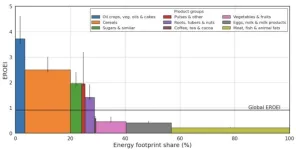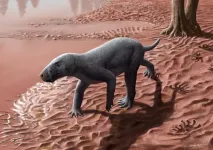(Press-News.org)
Almost three quarters of adolescents in Australia experience clinically significant depression or anxiety symptoms, with most being chronic, according to a new study. And preventive strategies outside our clinics are urgently required to address this considerable public health problem facing the nation.
The research, led by Murdoch Children’s Research Institute (MCRI) and published in The Lancet Psychiatry, found mental health problems were frequently chronic with 64 per cent reporting symptoms three or more times across their adolescent years.
MCRI Dr Ellie Robson said the rate and recurrence of depression and anxiety symptoms were concerning given mental health problems during adolescence had serious consequences across the lifespan.
“These are striking findings, particularly given how many young people experienced symptoms over multiple years of the study and how much depression and anxiety symptoms can affect young people’s functioning and can have long-lasting negative health outcomes,” she said.
For the study 1,239 children from Melbourne enrolled in the Child to Adult Transition Study (CATS) had their symptoms of anxiety and depression tracked every year from 10 to 18 years of age.
Girls were at increased risk with 84 per cent compared to 61 per cent of boys having depression or anxiety symptoms at least once during adolescence. Girls were also more likely to have a chronic course at 72 per cent and 49 per cent, respectively.
The onset of anxiety and depression symptoms increased at times that coincided with educational stress such as the primary to secondary school transition, exam periods and the end of compulsory education. Three quarters of participants who struggled with mental health problems during the COVID-19 years already had symptoms, highlighting factors beyond the pandemic stressors.
MCRI Professor Susan Sawyer said that despite growing concerns about adolescent mental health, until the CATS, few studies had comprehensively charted the course of common mental disorders across this key life stage.
“To our knowledge, this longitudinal study shows the highest cumulative incidence of clinically significant symptoms of common mental disorders that has ever been reported across adolescence from any country,” she said.
“This high incidence of common mental health problems suggests that even the most well-resourced country would struggle to provide adequate treatment if every young person sought help. Beyond clinical care, we urgently need to fund, develop and evaluate preventive strategies that aim to reduce the onset and chronicity of depression and anxiety.”
Dr Robson said; “Adolescents today are growing up in a distinctly different psychosocial landscape than earlier generations, one that is characterised by greater mental health literacy, reduced stigma, and at times the glamorisation of mental health problems. Given this context, our next step will be to explore what impact these reported symptoms have on the functioning and health outcomes of contemporary adolescents.”
GenV, tracking the health and wellbeing of Victorians, from birth to old age, will also provide invaluable insights into the health challenges faced by our young people including mental health problems.
One of the world’s largest-ever birth and parent cohort studies, GenV has seen almost 50,000 babies (over 100,000 newborns, mothers and fathers) sign up. Recruitment for children born in 2021-2022 is still open. Learn more on the GenV website.
Researchers from The Royal Children’s Hospital, the University of Melbourne, Deakin University and the University of Bristol also contributed to the findings.
Publication: Robson EM, Husin HM, Dashti SG, Vijayakumar N, Moreno-Betancur M, Moran, Patton GC and Sawyer SM. ‘Tracking the course of depressive and anxiety symptoms across adolescence (the CATS study): a population-based cohort study in Australia,’ The Lance Psychiatry. DOI: 10.1016/S2215-0366(24)00361-4
*The content of this communication is the sole responsibility of MCRI and does not reflect the views of the NHMRC.
Available for interview:
Professor Susan Sawyer, MCRI, Group Leader, Adolescent Health
Dr Ellie Robson, MCRI, Adolescent Health researcher
END
A primary output of agriculture is food, an energy source for the human body. But agriculture also requires energy inputs. Kajwan Rasul and colleagues calculated the global energy return on investment for agriculture over time from 1995 to 2019. The authors constructed a model using two existing models, one that captures the energy use of agriculture and food processing and another that captures flows of agricultural commodities. The authors find that the return on energy investment for global agriculture has increased from .68 to .91 over ...
Most major large language models (LLMs) can quickly tell when they are being given a personality test and will tweak their responses to provide more socially desirable results—a finding with implications for any study using LLMs as a stand-in for humans. Aadesh Salecha and colleagues gave LLMs from OpenAI, Anthropic, Google, and Meta the classic Big 5 personality test, which is a survey that measures Extraversion, Openness to Experience, Conscientiousness, Agreeableness, and Neuroticism. Researchers have given ...
Chimeric antigen receptor (CAR) T-cell therapy is a type of cancer immunotherapy where patients’ T-cells are collected and genetically modified to produce chimeric antigen receptors that recognize specific targets on cancer cells, allowing these T-cells to locate and destroy the cancer cells. CAR T-cell therapy shows promising results in treating relapsing or refractory B-cell lymphomas. To explore the risks associated with CAR T-cell therapy, researchers from Juntendo University, Japan, including Professor Jun Ando, Professor Miki Ando, and Dr. Erina Hosoya, published a study in Haematologica on October 17, 2024.
Elaborating about this study further, Dr. Hosoya, ...
After taking the first images of black holes, the ground-breaking Event Horizon Telescope (EHT) is poised to reveal how black holes launch powerful jets into space. Now, a research team led by Anne-Kathrin Baczko from Chalmers University of Technology in Sweden has shown that the EHT will be able to make exciting images of a supermassive black hole and its jets in the galaxy NGC 1052. The measurements, made with interconnected radio telescopes, also confirm strong magnetic fields close to the black hole’s edge.
The main research question for the project’s ...
LOS ANGELES — USC Norris Cancer Hospital was named a Top Teaching Hospital by The Leapfrog Group, a leading national patient safety watchdog organization, for the fourth consecutive year.
“The Leapfrog Top Hospital award is one of the most competitive awards a hospital can receive, and we are delighted that USC Norris Cancer Hospital places among the highest-rated hospitals in the nation once again,” said Marty Sargeant, MBA, CEO of Keck Medical Center of USC, which includes USC Norris Cancer Hospital.
To qualify for the distinction, hospitals must rank top among peers ...
The formation of blood vessels is a complex process involving the interplay of proteins and mechanic forces. In two studies, a research team at the Biozentrum of the University of Basel, Switzerland, has uncovered new mechanisms in blood vessel formation. The team demonstrated how cells interact during vascular lumen formation and the critical role of dynamic forces in this process. These new insights into blood vessel formation may provide potential approaches in the treatment of vascular diseases.
Blood vessels run throughout the entire body, delivering nutrients and oxygen through the circulating blood. During vessel formation, cells first form local ...
Gorgonopsians are an extinct group of synapsids that lived during the Permian, between 270 and 250 million years ago. They belong to the evolutionary lineage that would give rise to the first mammals 50 million years later. They were warm-blooded animals like modern mammals, but, unlike most of them, they laid eggs. They were carnivorous and were the first animals to develop the characteristic saber teeth. They were often the superpredators of the ecosystems in which they lived, and their appearance would be similar to a dog, ...
The first true mammals evolved roughly 200 million years ago, during the early days of the dinosaurs. But mammals are the last surviving members of an older group, called the therapsids. At first glance, many therapsids weren’t obviously mammal-like , but they also had subtle features that we recognize in mammals today, like a hole on the sides of their skull for the jaw muscle to attach and structures on their jaw bones that would eventually evolve into mammals' distinctive middle ear bones. In a new paper in the journal Nature Communications, scientists announce the discovery of a fossil therapsid ...
Researchers have used a chemical compound to light up treatment-resistant cancers on imaging scans, in a breakthrough that could help medical professionals better target and treat cancer.
The authors at King’s College London say that using the radiotracer – an injected compound used in PET scans – could help inform doctors that a patients aggressive cancer will not respond to chemotherapy before treatment is given. This would prevent the patients receiving unnecessary treatment and provide them with alternative options that will give them the best chance of beating the disease.
The ...
Osaka, Japan – From the very moment an egg is fertilized, life begins with a remarkable process: cells start dividing and replicating to make copies of themselves. Yet this process is not flawless. Errors can occur when genetic material is copied, creating “unfit” cells that don’t work properly. To keep development on track, cells employ a fascinating quality control system called cell competition. However, much about this mechanism remains unclear.
Now, in a study recently published in Nature ...







